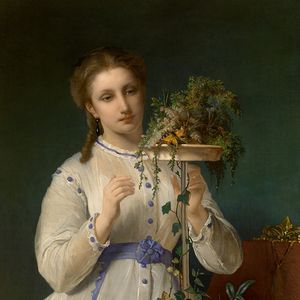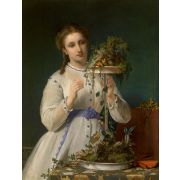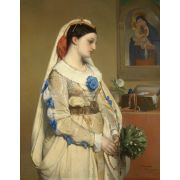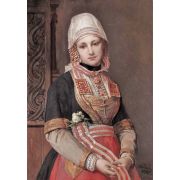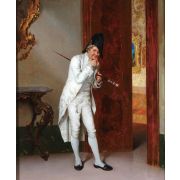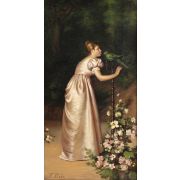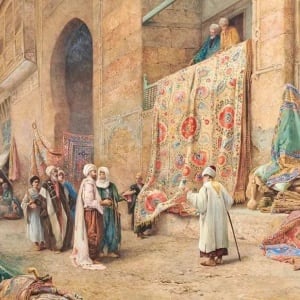
Orientalism
Orientalism
1 to 2 out of 2 artists
Jean-François Portaels
1818 -1895, Belgian / Orientalism and Academic Art, 33 works
Francesco Beda
1840 -1900, Italian / Academic Art and Orientalism, 11 works
1 to 2 out of 2 artists
Orientalist painters portrayed the exotic 'East' in their paintings with snake charmers, veiled ladies, and courtesans. Orientalism refers to 19th-century Western (mainly English and French) artwork, architecture, and decorative arts that draw from Turkey, Egypt, India, China, and Algeria. Many artists subsumed these countries' individual cultures and practices into a generic vision of the Orient. Historian Edward Said notes in his influential book Orientalism (1978) that "the Orient was almost a European invention...a place of romance, exotic beings, haunting memories and landscapes, remarkable experiments." Orientalist art included historical and biblical paintings, nudes, and domestic interiors.
Orientalism began in the 1500s. Venice fought Sultan Mehmet II's Ottoman Empire from 1463 until 1479. Venice was beaten and compelled to pay indemnities to trade on the Black Sea. Gentile Bellini, the Doge of Venice's court painter, was dispatched to serve the Sultan in 1479. Bellini returned to Venice in 1481 but continued to use oriental elements, as shown in St. Mark Preaching in Alexandria (1504-1507).
Veronese and others imitated Bellini, resulting in several Middle Eastern-themed Venetian artworks. Veronese's The Wedding Feast at Cana (1563) portrays Jesus at the table after turning water into wine. On his right are Christian guests and followers in Western garb, while on his left are Oriental-dressed Jews. Identifying Jews via Oriental imagery became a standard art method, exemplified in Gustave Doré's La Grande Bible de Tours engravings (1866).
In 1536, France joined the Franco-Ottoman Alliance, which lasted until 1798. During the 1700s, French art mirrored the popularity of Turkish products. Jean Baptiste Vanmour, Charles-André van Loo, and Jean-Étienne Liotard headed the Turquerie movement, and the style became part of Rococo art, as evidenced in Liotard's Portrait of Maria Adelaide of France in Turkish-style attire (1753).
Napoleon Bonaparte's invasion of Egypt in 1798 and control of the nation until 1801 ushered in Orientalism as a movement. Books also contributed. Archeologist Baron Dominique-Vivant Denon wrote Voyage through Lower and Upper Egypt during Napoleon's Campaigns (1802). Egyptian funeral columns, tombs, and temples impacted French decorative arts and architecture. The French government's 24-volume Description de l'Égypte (1809-1822) also had a lasting impact.
Antoine-Jean Gros founded Neoclassical Orientalism. Napoleon commissioned him to portray his 1799 visit to his plague-stricken troops at Jaffa, Syria. Napoleon in the Plague House at Jaffa (1804) was shown in the 1804 Paris Salon. The work was meant as propaganda for French imperialism in Egypt, giving an ill-fated campaign a heroic spin. The architectural backdrop evokes Jacques-Louis David's Oath of the Horatii (1784), while a horseshoe arch, city walls, mosque, and Syrian man offering food to the ill provide historical authenticity. Gros' painting represented Neoclassicism and Orientalism.
La Grand Odalisque (1814) helped create Orientalism and dominate Academic art. Queen Caroline Murat of Naples commissioned the artwork, which employed typical representations of Venus in a Middle Eastern background. In the 1660s, the French started utilizing odalisque for harem concubines. Taken from the Turkish 'modal' meaning 'chambermaid,' the name refers to a young female slave, not a concubine but a maid, clothed in the same garments as male pages. Ingres' title linking 'odalisque' to the nude began Orientalism, and he returned to the topic of Odalisque with the enslaved person (1839). Ingres never visited the Near or Middle East but relied on the stories of others, especially Lady Mary Wortley Montagu's Turkish Letters (1763). Montague contrasted her descriptions of India with Orientalism's idealized notions. She disputed masculine depictions of Turkish baths as sexualized scenes by calling them "the Women's coffee house" Ingres and other painters used her details and locations to create scenarios and topics.
Eugène Delacroix traveled to Morocco in 1832 with a diplomatic entourage and did drawings and paintings. After returning to Paris, he painted Algiers Apartment Women (1834). Gustave Plance remarked that the picture was "new, strong, advanced in spirit, and entirely Venetian" when presented at the 1834 Paris Salon. The image helped popularize harem themes and sparked Romantic artists' interest in Orientalist topics.
Orientalism influenced religious painting as painters strove to depict biblical events accurately. This is found in Alexandre-Gabriel Decamps' The Finding of Moses (1837) and Joseph Sold by His Brethren (1838). (1838). William Holman Hunt, a leader of the Pre-Raphaelite Brotherhood, traveled to Palestine in the 1850s to use ethnographically accurate details for The Scapegoat (1854-55) and The Finding of the Savior in the Temple (1854-55). The Russian Peredvizhniki group used a Realist approach to their religious scenes set in the Holy Land, as seen in Vasily Polenov's Christ and the Woman Taken in Adultery (1888) and Ilya Repin's (1871).
Alexandre-Gabriel Decamps was the best-known Orientalist painter. These works, especially The Turkish Patrol (1831), started his career in the 1831 Paris Salon. His portraits of Middle Eastern children and merchants were popular with the middle class and inspired Delacroix. Jean-Léon Gérôme's The Mandolin Player (1858) and Nasreddine (Alphonse-Etienne) Dinet's Dancers are further examples (c.1904). Demand for Orientalist genre scenes increased over Europe, enabling John Frederick Lewis, Rudolf Ernst, Gustav Bauernfeind, and Giulio Rosati to create their style and images.
Popular genres were harems and slave markets. Giulio Rosati's Inspection of New Arrivals (undated), Jean-Jules-Antoine Lecomte du Nouy's The White Slave (1888), and John Frederick Lewis's The Harem - Introduction of an Abyssinian enslaved person are examples (c.1865). These sculptures portrayed a naked enslaved woman and accentuated her white complexion. Edward Said says that the genre's success relied on the image of the Orient as a destination to find sexual experiences unavailable in the West. Men weren't permitted in harems, but painters used dreams, rumors, and European models to create these pictures. Art historians like Todd Potterfield see the masculine gaze piercing the harem as the West's ambition to dominate 'the other.'
Antoine-Jean Gros pioneered dramatic, military Orientalism with Bataille d'Aboukir (1806), which depicts a Napoleonic fight against the Ottoman Empire. Battle images showing heroic French troops and activities against Muslim armies were promoted by Napoleonic propaganda. These themes, reinterpreted by the Romantic Movement, lasted until the mid-1800s and were fueled by Ottoman conflicts.
From 1821-1830, Greece battled for freedom from the Ottomans and European artists and intellectuals associated with them (1824). The work mirrored Romanticism's focus on dramatic suffering and solid emotional emotions. In 1830, the French invaded Algeria and painted images from the long fight to conquer the area, which lasted until 1847. (1854).
Alexandre-Gabriel Decamps' Defeat of the Cimbri (1833) depicts the Romans' destruction of the Cimbri tribe in 102. Most of these paintings equated Oriental topics and locations with brutal violence and savagery, as shown in Delacroix's Convulsionists of Tangier (1837-1838), which offers a Muslim brotherhood as a dangerous swarm of zealots.
The Society of French Orientalist Painters was created in 1893 to promote Orientalism and encourage French painters to travel. Nasreddine (Alphonse-Etienne) Dinet, Maurice Bompard, Eugene Giradet, Paul Leroy, and Jean-Léon Gérôme were key Society players. Leonce Benedict was the Society's president from its founding until 1925. The Society supported colonial control in North Africa and the Middle East via its Salons and publications.
Despite such organizations, Orientalism declined by the end of the 19th century. Academic art appeared dated as Tonalism, Aestheticism, Impressionism, and Post-Impressionism emerged in the 19th century. Japonism, which was connected to Orientalism, impacted many of these groups.
Paul Gauguin moved to Tahitian topics and ideas, while Pablo Picasso and Henri Matisse were inspired by African art. Paul Klee, Wassily Kandinsky, Oskar Kokoschka, and Auguste Macke developed orientalist-inspired skills in the 20th century.
Contemporary artists have cited the Orientalist works of Delacroix, Ingres, and others, reinterpreting them via Edward Said's and subsequent feminist and post-colonialist criticisms. Algerian Houria Niati recasts Delacroix to disprove "the 19th-century perception of the strangeness of then French Algeria," while Moroccan Lalla Essaydi reframes Delacroix, Ingres, and other Orientalists. French-Algerian Zineb Seder develops video installations and pictures of colonial displacement and history. Turkish Nil Yalter's video artwork depicts the 'disidentified' Orientalism lady. Performer ükran Moral The Turkish Bath (1997) and Double Action Series for Oriental Fantasies (2000) criticize Orientalism and clichés. Huma Bhabha sculpts using found materials, like in The Orientalist (2007) "Egyptian sitting figure" to portray "materials' textural characteristics. The Orientalist's masklike look reminds me of Dorian Gray's. The title linked Oscar Wilde's metaphor to Edward Said's criticism of Western arrogance."
